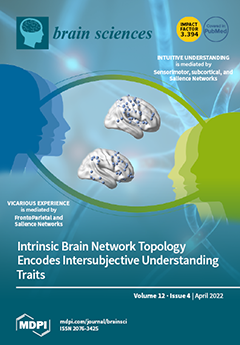It is generally believed that eye movements are completely spared in amyotrophic lateral sclerosis (ALS). Although a series of eye movement abnormalities has been recognized in recent years, the findings are highly controversial, and bulbar disabilities should be considered in relation to eye
[...] Read more.
It is generally believed that eye movements are completely spared in amyotrophic lateral sclerosis (ALS). Although a series of eye movement abnormalities has been recognized in recent years, the findings are highly controversial, and bulbar disabilities should be considered in relation to eye movement abnormalities. The present study aimed to determine whether eye movement abnormalities are present in ALS and, if so, to investigate their characteristics and their association with bulbar disability in ALS patients. A total of 60 patients and 30 controls were recruited and underwent the standardized evaluations of the oculomotor system using videonystagmography. Square-wave jerks (OR: 16.20, 95% CI: 3.50–74.95,
p < 0.001) and abnormal cogwheeling during smooth pursuit (OR: 14.04, 95% CI: 3.00–65.75,
p = 0.001) were more frequently observed in ALS patients than in the control subjects. In subgroup analyses, square-wave jerks (OR: 26.51, 95% CI: 2.83–248.05,
p = 0.004) and abnormal cogwheeling during smooth pursuit (OR: 6.56, 95% CI: 1.19–36.16,
p = 0.031) were found to be more common in ALS patients with bulbar involvement (
n = 44) than in those without bulbar involvement (
n = 16). There were no significant differences in the investigated eye movement parameters between bulbar-onset (
n = 12) and spinal-onset patients (
n = 48). ALS patients showed a range of eye movement abnormalities, affecting mainly the ocular fixation and smooth pursuit systems. Our pioneering study indicates that the region of involvement could better indicate the pathophysiological essence of the abnormalities than the type of onset pattern in ALS. Eye movement abnormalities may be potential clinical markers for objectively evaluating upper brainstem or supratentorial cerebral lesion neurodegeneration in ALS.
Full article






